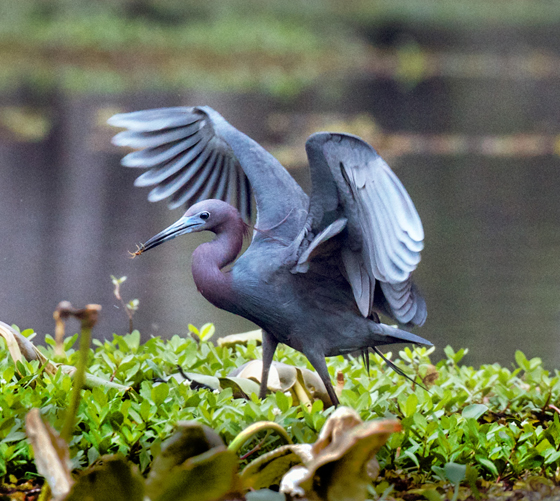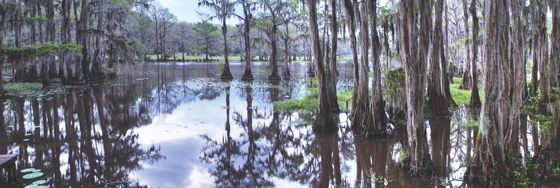Caddo Lake: Visions of a Southern Cypress Lake

2025 Spring Antiques Show | March 20 – April 6
2025 Fall Antiques Show | October 4 – 18


Caddo: Visions of a Southern Cypress Lake is a stunning tribute to one of Texas’ most enigmatic waterways. Thad Sitton, a veteran East Texas historian, and Carolyn Brown, a professional photographer, have created an homage to Caddo Lake, a lake like no other—half Texas, half Louisiana, a swampy labyrinth of bald cypress and water plants filled with mystery, legend and a staggering amount of biological complexity.
Often touted as the only natural lake in Texas, Caddo is actually preserved at its original level by a simple U.S. Corps of Engineers dam on the Louisiana side. Formed by floods around 1800 in the valley of Big Cypress Bayou and by the eccentricity of the Red River, Caddo Lake today is a maze. Only the most experienced backwater guides navigate outside the well-marked boat trails.
Around 27,000 acres of water—averaging only 4 ½ feet deep—provide habitat for alligators, snapping turtles and gars; beavers, otters and mink; herons, hawks and pelicans; amphibians, fish and snakes; and a special brand of people that includes both subsistence fishermen and hunters as well as well-heeled urban refugees.

Locals will tell you: “No day is like any other on Caddo Lake” and warn: “You never know down here.” Birds might fly a little too close for comfort, nocturnal animals could decide to visit your canoe in broad daylight and you might spy a creative fisherman pulling his catch out of the water by hand.
In an effort to describe the vast array of biodiversity at Caddo, Sitton observed, “Many strange sounds come out of the woods at Caddo. Some 213 bird species spend part of their year at the lake as do 55 mammals, 92 fish, 29 amphibians and 60 reptiles. No other place in Texas or Louisiana has anything like this Noah’s Ark of species gathered together in a relatively small area, 44 of them classified as threatened and endangered.”
Caddo is a place where many different habitat types merge blending to form a unique ecosystem. Water, trees and swamp come together to create an environment more like a labyrinth than the term “lake” implies.
The trees that grow from this lake are an oddity. Cypress seeds require damp soil to germinate but are supposed to grow near water, not in it. Not in Caddo where you can find them growing in the middle of the lake. Here they not only grow but provide places for other life to thrive.
Sitton explained, “Mysteries of the cypresses abound, and newcomers, often slightly nervous people in small boats, often are a little taken aback by the bald cypress trees normally found draped with Spanish moss and growing over black water. As at Caddo Lake, the spreading bases—buttresses—of such trees usually look worn down by wear and tear from all the animals that pull themselves out of the water to sunbathe, stalk prey, eat a fish or take a rest.

“Each buttressed trunk forms a little island of life. Many plants, even young sweetgum trees, grow out of pockets of soil accumulated on top of the buttresses. Turtles, snakes, alligators, nutrias, otters, wading birds and many other ‘creatures from the black lagoon’ use the cypress islands.”
Caddo is classified as a Category 1 Habitat for wildlife by the U.S. Fish and Wildlife Service and encompasses a state wildlife management area as well as a state park. Caddo Lake and adjacent areas have also been designated as a Ramsar Site under the international convention to preserve world-class wetlands and their waterfowl. It is Texas’ first and only Ramsar site.
The designation as “Wetlands of International Significance” is not only important in helping preserve the wetlands but also in generating interest and tourism. A unique place such as Caddo must be preserved. Currently, like many lakes in Texas, Caddo is threatened by Giant Salvinia, a fast-growing invasive species. The Center for Invasive Species Eradication is working hard to remove it, but Giant Salvinia is a stubborn, resilient and aggressive plant.
Caddo is a place like no other in Texas that must be seen to be understood and appreciated. In words and pictures, writer Thad Sitton and photographer Carolyn Brown have captured the human, animal and plant life of Caddo as well as the history of the lake itself, which has been aptly described as an ever-changing network of cypress woodlands, bayou-like channels, water-plant meadows and hardwood bottoms covered more or less by water.
[line]
BOOK INFORMATION
Publisher: Texas A&M University Press
Author: Thad Sitton
Photographer: Carolyn Brown
11”x10”, 188 pp., 109 Color Photos
Cloth: $30, ISBN #978-1-62349-239-7
Order at: www.tamupress.com or by phone at 800-826-8911
[line]
by Christine Brown
As one of the top 20 university presses in the nation, the Texas A&M University Press publishes up to 65 new titles annually. Subjects range from borderland studies, gardening and horticulture, military history, natural history and the environment, presidential studies and works on the history and culture of Texas and the Southwest. Knowing the Roundtopolis is a melting pot of people with far-ranging interests, the press staff provides a book review each quarter highlighting one of its titles.
2025 Spring Antiques Show | March 20 – April 6
2025 Fall Antiques Show | October 4 – 18